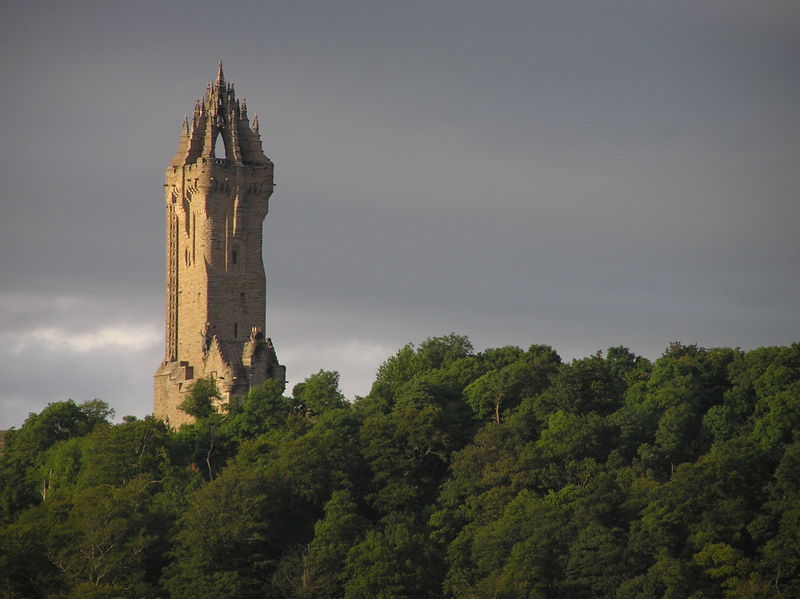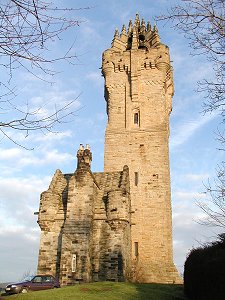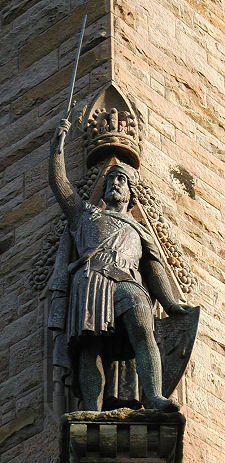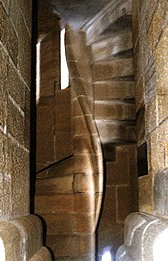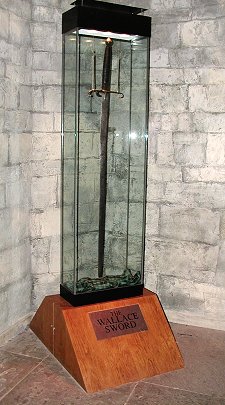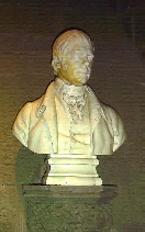| This Week’s Topic… | |||

Best viewed in
|
Wallace Monument
The Wallace National Monument (generally known as the Wallace Monument) is a tower standing on the summit of Abbey Craig, a hilltop near Stirling in Scotland. It commemorates William Wallace, the 13th century Scottish hero. The tower was constructed following a fundraising campaign which accompanied a resurgence of Scottish national identity in the 19th century. In addition to public subscription, it was partially funded by contributions from a number of foreign donors, including Italian national leader Giuseppe Garibaldi. Completed in 1869, the monument is a 220 foot sandstone tower, built in the Victorian Gothic style. The monument stands on the Abbey Craig, a volcanic crag above Cambuskenneth Abbey, from which Wallace was said to have watched the gathering of the army of English king Edward I, just before the Battle of Stirling Bridge.
The foundation stone was laid on Bannockburn day 1861, and the completed monument was handed over to the Custodians on 11th September 1869 on the 572nd anniversary of Wallace's famous victory at the Battle of Stirling Bridge. Money was collected from Scots world-wide for the project, which in turn inspired the setting up of the Wallace statues in Baltimore in the United States and Ballaret in Australian goldfields. The design of the monument is in the Scottish "Baronial" style and represented a Scottish Medieval tower, rising from a courtyard, with a representation on the top of the Crown Royal of Scotland. The design has been much criticized for its fanciful combination of secular and ecclesiastical elements. The monument is 220 feet high, 54 square feet at its base, with the tower 36 square feet. The walls are 16/18 feet at their thickest, tapering to 5 feet thick at their thinnest. It is estimated that there were in excess of 30,000 tons of stones used in the construction. The monument was built with a caretaker's house attached. Today, that space is now occupied by a gift shop and tea room (which was originally the caretaker's kitchen and parlor). The statue of Wallace on the outside of the building is solid bronze and was sculpted by David Watson Stevenson. It is situated approximately 30 feet from the ground, and the statue itself stands around 15 feet tall. Visitors to the Wallace Monument leave their cars at the foot of Abbey Craig, which they then climb to reach the foot of the monument. A minibus service is also available from the Pavilion Visitor Centre next to the car park. In the entrance foyer of the Monument itself there is a display about Sir William Wallace and about the construction of the Monument. Internally there are four rooms in the tower of approximately 25 square feet, with vaulted ceilings 20/30 feet high. The tower rooms are connected by a spiral staircase in the north-west corner.
246 narrow steps take you to the top of the tower and there are three chambers where you can stop off during your climb. The first 71 steps up to Level 1 bring you to a display telling the story of the life of Wallace and of the Battle of Stirling Bridge. Here the highlight is a 3-D simulation in which Wallace appears at his trial at Westminster Hall, telling his own story via the 'William Wallace Talking Head'. Also on display is what is said to be the 700 year old Wallace sword, some 5 feet 4 inches long. Coming face to face with such a magnificent piece of metalwork you wonder how anyone could have lifted or carried it, still less fought with it. The sword is a traditional two-handed broad-sword, 71.5 inches in length. It weighs six pounds. Little is known about the origins of the sword for it carries no maker's mark and is therefore difficult to date. The quality of the metal used for the blade suggests that it may have been forged in Scotland (unlike other swords of the period which were often Flemish or German in origin). King James IV ordered the sword to be re-hilted in 1505, so that it would be more fitting to Scotland's National Hero. The size of the sword indicates that Sir William Wallace must have been at least six feet six inches tall. The sword was traditionally kept in Dumbarton Castle until 17 November 1888 when it was handed over in Stirling Castle - to Rev Charles Rogers who had started the Wallace Monument project in the first place. 64 more steps will bring you to Level 2 and the Hall of Heroes. In the Scottish Hall of Heroes you will meet other great Scots sculpted in marble. The third floor of the Wallace Monument contains a 360° diorama where you will learn about the history of the surrounding landscape. On the viewing platform above you will witness one of the finest views in Scotland, over the town of Stirling and the carseland of the Forth Valley, as far as the Forth bridges in the East and Ben Lomond in the West. The final pull leads to The Crown of the Monument with its breathtaking views bringing the Diorama to life and making every one of those 246 steps worthwhile. |
||
